On looking down
Wildflowers along the Crabtree Creek and its tributaries, August 2023
Walking mostly on residential streets you tend to see the same things over and over again. My neighborhood was built before 1950, and there are still vestiges of the diversity of early twentieth-century construction, including some Craftsman cottages; but much of it has been redone, expanded, or replaced by bigger houses, and the new construction has, for all its pretension to uniqueness, a depressing sameness. Even when the old architecture shows through, the houses tend to be painted the same dull colors and have the same dull landscaping. I imagine you could take a family from each of the UN’s 193 member states, like a Benneton ad for urban development; plunk them down in a nice neighborhood in Raleigh, and in twelve months 180 of them would have neatly mown lawns adorned with five to seven of the same two dozen ornamental plants; also they’d have painted their wonderfully mottled brick a uniform shade of off-white.
It gets so when I see a house that’s different I’m moved to poetry, as I was last year:
Sing what no neighbor dares confess Amid the squalid safety of the new (Constructed character of mismatched cubes, Rectilinear gardens, monochrome)— This cottage clothed in cheerful dereliction, The color of a child’s crayon sun, With window-box and dooryard in a mania Of zinnia, petunia, gazania— Accidentally annexed, arrises askew, Gilded, bowered, vine-rife, breeze-cleaned, bird-rung. Why scorn what abundant life includes, Careless or a contrary ambition? Whatever saints and sinners call this home, God bless and keep them in their foolishness.
Yesterday I saw a house with purple columns on its porch. The rest of the house and porch were painted a perfectly sane shade of yellow or off-white, I forget which; but the columns were bright purple. I didn’t write a sonnet, but I was happy. On another street — I can never remember which one, and so I’m always glad when I find it again — someone has half-hidden old desktop telephones in the shade and mulch of her wooded yard.
Often, though, the best way to find diversity is to seek out the places no one has yet bothered to scour — and then to look not around, but down. There are the lunatic fungi, the insects and centipedes and worms, the textures of stone and earth and, yes, even cement and blacktop that persist beyond our attention. Leave things alone and they tend to get more interesting. The random splatter of broken glass on the sidewalk is prettier than most yard art.
In summer, there are wildflowers. These take more sustained neglect than most decent folk will allow, but they still flourish here and there along creeksides, and also along the city’s greenways, where neglect is (for once) a functional and salutory public policy. Below are nine I found the first week of August within a couple miles of my house.
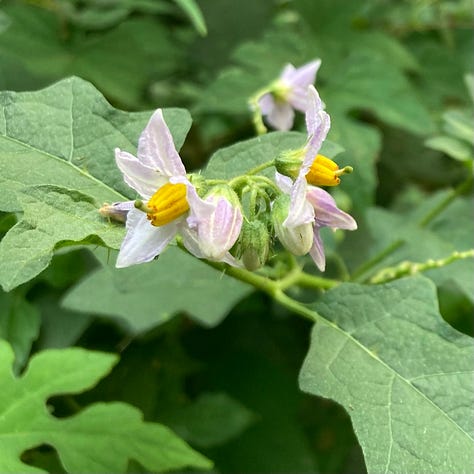
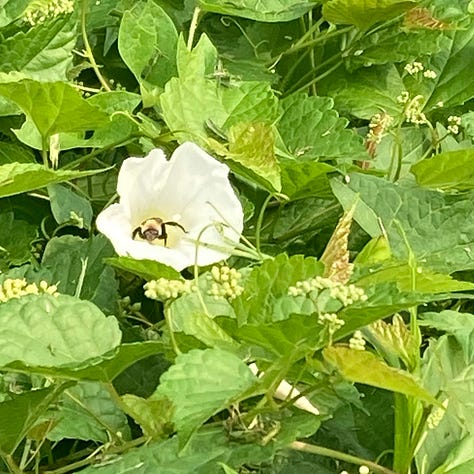
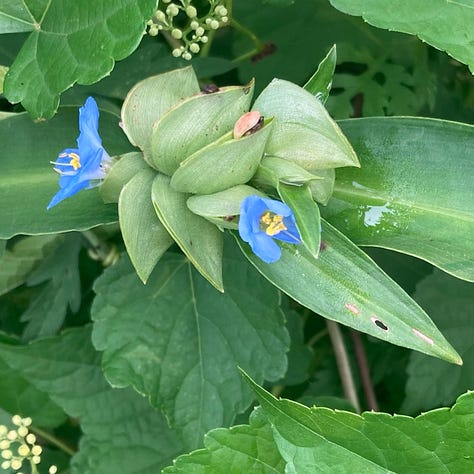
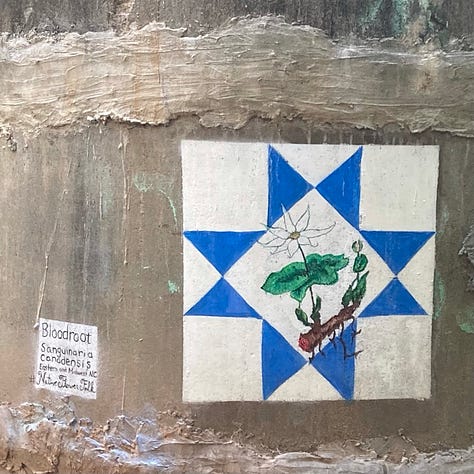
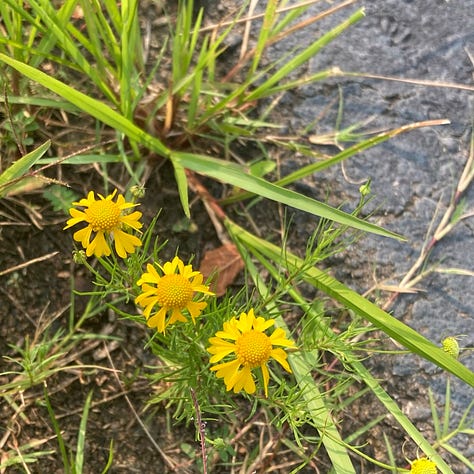
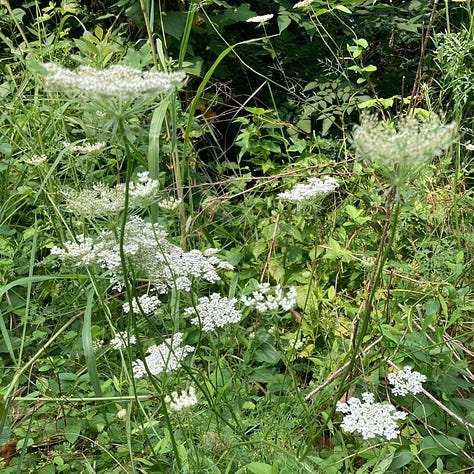
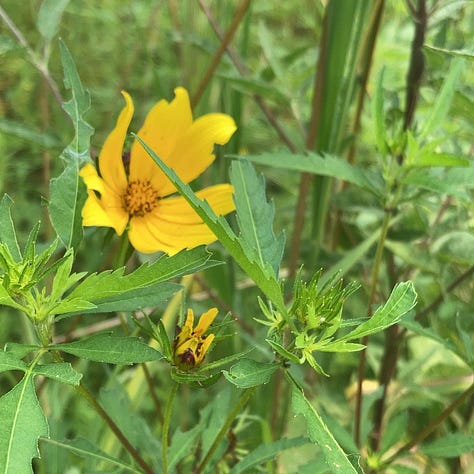
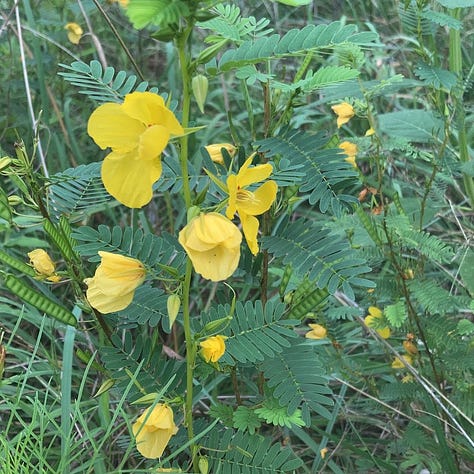
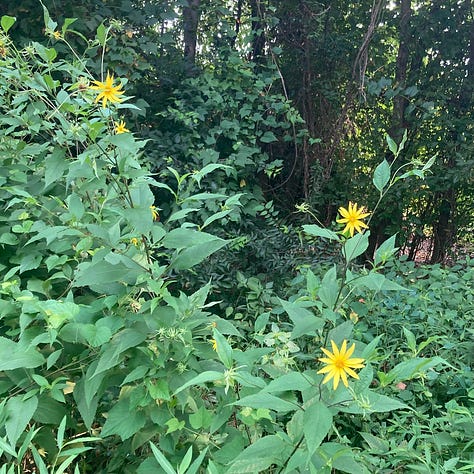
The Carolina horsenettle grew by a fire hydrant on a busy street; the rest volunteered along a greenway — except the bloodroot, of course, which is the work of some kindred spirit. What I didn’t recognize, I used an app and a wildflower guide to identify. Here’s what I know about them:
The Carolina horsenettle grew by a fire hydrant on a city street, uphill of a little creek. Its delicate lavender looks like the eggplants in my garden; it is a nightshade, and at least a little bit deadly.
Morning glory grows rampant at the woods’ edge behind a car dealership. The bumblebees are appreciative.
The bright blue Virginia dayflower is a surprise in the landscape — if you notice it at all; it’s short and quite small. They grow, as this one did, in wet soil by streambanks, though I spotted a stand of them a few days later growing by a telephone pole. Some people say they are good in a salad, but some people say that about almost anything.
The bloodroot, whose roots were once used to dye fabric (red, natch), would be out of season if it were real; it blooms in spring. The artist takes inspiration from antique quilts.
The texture of bitterweed petals is my favorite new thing; I want to use them for a carving motif. Related to sunflowers and daisies, it grows wild in meadows where cows graze and (though I have not experienced this personally) makes their milk taste bitter.
Queen Anne’s lace, or wild carrot, is not native to North America but was introduced as a medicinal herb. Whether it’s a pretty flower or a noxious weed depends on your perspective. Like parsley, to which it is related, it provides food for caterpillars of black swallowtail butterflies… but not much else.
Related to sunflowers, Bidens aristosa is commonly called tickseed beggarticks, bearded beggarticks, bur marigold, swamp marigold, or (my favorite) Yankee lice. As you might guess, its fruit is a burr that sticks to fur and clothing. Common in wet meadows; I found it in poorly drained ground by a stream. (By the by, history records that Rebel soliders were equally great purveyors of lice.)
The partridge pea is obviously a pea flower, and its leaves do resemble some great bird’s feathers, though I gather it takes its name from the bobwhite and quail that eat its seeds. Where it grows alone and tall it makes a dramatic display.
I was surprised to discover that these twelve-petal sunflowers were Jerusalem artichokes. A perennial native to prairies, in North Carolina they are an invasive species, mainly because they spread so effectively, both by tuber and by seed. As the tubers are excellent roasted, there’s an obvious solution to the problem. (They do taste faintly reminiscent of artichokes, if you have a good imagination.) In the meantime, there are uglier things that could take over your roadside.
It should go without saying that you’ll miss most of these little gems from a car. Even, most likely, from a bicycle. It’s only walking that gives me the freedom to think as much about where I am as where I’m going.
Notes
The app I use to identify life forms on away missions is called Seek, by iNaturalist. It was recommended to me by someone I passed hiking on Grandfather Mountain who saw me puzzling over a flower. It uses the phone’s camera and GPS information to home in on a species, and it works fairly well, all things considered.
My wildflower guide is Justice, Bell, & Lindsey’s Wild Flowers of North Carolina, 2d. ed. (2005).
I have some thoughts about what makes a good field guide, but I’ll save them for another post.


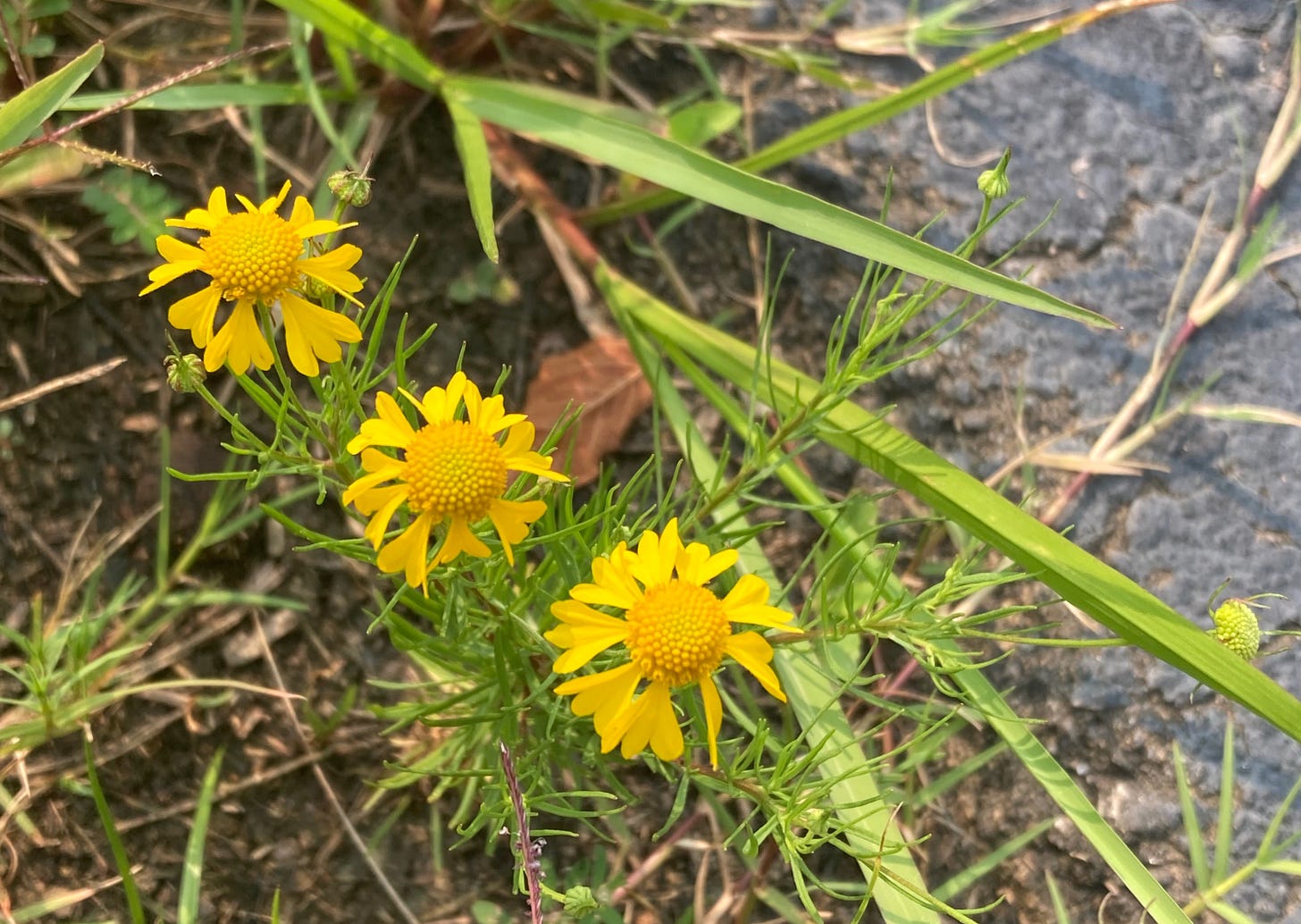
I love neglect as a policy! Our family stayed in Le Vésinet, a garden city outside of Paris, for a couple of weeks in May and their greenways existed in a state of studied neglect. Wildflowers sprouted all along the sidewalks. It was beautiful—and something we were only able to notice because we had to walk a kilometer to get to the train station.